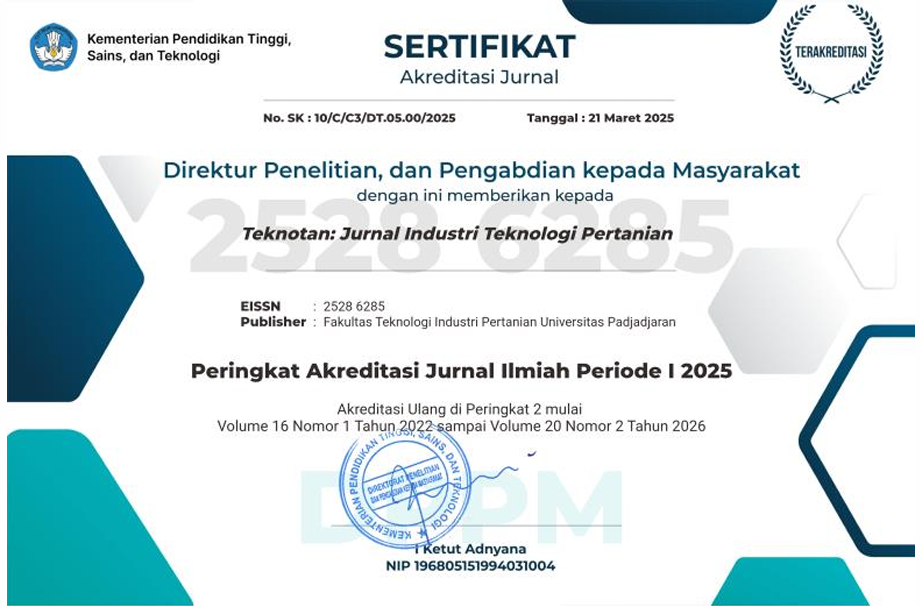Sifat Fisikokimia dan Komposisi Nutrisi Pada Gula Cair yang Diproses dengan Metode Vakum
Abstract
Faktor utama penyakit diabetes adalah tingginya konsumsi gula dalam produk makanan, minuman, dan kembang gula. Nira memiliki nilai indeks glikemik yang lebih rendah sebesar 35, sehingga dapat dijadikan sebagai pemanis yang lebih sehat. Nira adalah minuman manis dan transparan yang populer diberbagai negara karena nilai kesehatannya yang tinggi. Selain itu merupakan salah satu minuman paling sehat dan tidak mengandung alkohol. Nira kelapa yang baru disadap mengandung 15-18% (b/v) sukrosa. Gula cair palma dari tiga varietas berbeda di Kecamatan Nglegok Kab. Blitar diteliti karena sifat fisikokimia dan nilai gizinya. Variasi viskositas, pH, total padatan terlarut, total keasaman, salinitas, aktivitas air, intensitas pencoklatan dan kandungan antioksidan dari Gula cair diamati di antara varietas tersebut. Gula adalah bahan kering utama yang disajikan dalam semua Gula cair, diikuti oleh protein dan abu. Total asam fenolik dan kandungan flavonoid total ditentukan dalam semua Gula cair dengan konsentrasi yang bervariasi. Hasil menyoroti variasi sifat fisikokimia dan komposisi nutrisi Gula cair. Secara keseluruhan, Gula cair dapat dikatakan sebagai pemanis alternatif untuk aplikasi dalam formulasi pangan fungsional.
Keywords
Full Text:
PDF (Bahasa Indonesia)References
Ajandouz, E.H. dan A. Puigserver, Nonenzymatic browning reaction of essential amino acids: effect of pH on caramelization and Maillard reaction kinetics, J. Agric. Food Chem. 47 (1999) 1786–1793.
AOAC, Official Methods of Analysis, Association of Official Analytical Chemists, Washington, DC, USA, 2000.
Banerjee, P., M. Satapathy, A. Mukhopahayay and P. Das. 2014. Leaf Extract Mediated Green Synthesis of Silver Nanoparticles From Widely Available Indian Plants: Synthesis, Characterization, Antimicrobial Property and Toxicity Analysis. Bioresources Bioprocess.1(3)
Barh, D., and Mazumdar, B. 2008. Comparative nutritive values of palm saps before and after their partial fermentation and effective use of wild date (Phoenix sylvestris Roxb.) sap in treatment of anemia. Research Journal of Medicine and Medical Sciences, 3, 173–176.
Benjakul, S., W. Visessanguan, V. Phongkanpai, M. Tanaka, Antioxidative activity of caramelization products and their preventive effect on lipid oxidation in fish mince, Food Chem. 90 (2005) 231–239.
Bouhlali, E.T., M. Derouich, R. Meziani, B. Bourkhis, Y. Filali-Zegzouti, C. Alem, Nutritional, mineral and organic acid composition of syrups produced from six Moroccan date fruit (Phoenix dactylifera L.) varieties, J. Food Compos. Anal. 93 (2020) 1–9.
Brudzynski, K. dan D. Miotto, Honey melanoidins: analysis of the compositions of the high molecular weight melanoidins exhibiting radical-scavenging activity, Food Chem. 127 (2011) 1023–1030.
Carocho, M., P. Morales, I.C. Ferreira. 2015. Natural food additives: quo vadis? Trends Food Sci. Technol. 45: 284–295.
Ebana, R.U.B., C.A. Etoc, U.O. Edet, Phytochemical screening and antimicrobial activity of Nypa fruticans harvested from Oporo River in the Niger Delta region of Nigeria, J. Sci. Res. 10 (2015) 1120–1124.
Francisco, J. -Ortega, S. Zona, Sweet sap from palms, a source of beverages, alcohol, vinegar, syrup and sugar, Vieraea. 41 (2013) 91–113.
Hebbar, K., Arivalagan, M., Manikantan, M., Mathew, A., Thamban, C., Thomas, G. V., & Chowdappa, P. 2015. Coconut inflorescence sap and its value addition as sugar–Collection techniques, yield, properties and market perspective. Current Science, 109, 1411–1417. https://doi.org/10.18520/cs/v109/i8/1411-1417
Ho, C.W., W.M. Aida, M.Y. Maskat, H. Osman, Effect of thermal processing of palm sap on the physico-chemical composition of traditional palm sugar, Pak. J. Biol. Sci. 11 (2008) 989–995.
Hu, F.B. 2013. Resolved: there is sufficient scientific evidence that decreasing sugar-sweetened beverage consumption will reduce the prevalence of obesity and obesity-related diseases, Obes. Rev. 14: 606–619.
Kahkonen, M.P., A.I. Hopia, H.J. Vuorela, J.P. Rauha, K. Pihlaja, T.S. Kujala, M. Heinonen, Antioxidant activity of plant extracts containing phenolic compounds, J. Agric. Food Chem. 47 (1999) 3954–3962.
Kongkaew, S. M. Chaijan, S. Riebroy, Some characteristics and antioxidant activity of commercial sugars produced in Thailand, Curr. Appl. Sci. Technol. 14 (2014) 1–9.
Kongkaew, S., M. Chaijan, S. Riebroy, Some characteristics and antioxidant activity of commercial sugars produced in Thailand, Curr. Appl. Sci. Technol. 14 (2014): 1–9.
Kurniawan, T., I. Kustiningsih, M.A. Firdaus. 2018. Palm sap sources, characteristics, and utilization in Indonesia, J. Food Nutr. Res. 6: 590–596.
Lertittikul, W., S. Benjakul, M. Tanaka, Characteristics and antioxidative activity of Maillard reaction products from a porcine plasma protein-glucose model system as influenced by pH, Food Chem. 100 (2007) 669–677.
Luis, G., C. Rubio, A.J. Gutierrez, C. Hernandez, D. Gonzalez-Weller, C. Revert, A. Hardisson, Palm tree syrup; nutritional composition of a natural edulcorant, Nutr. Hosp. 27 (2012) 548–552.
Malik, V.S. and F.B. Hu. 2015. Fructose and cardiometabolic health what the evidence from sugar-sweetened beverages tells us, J. Am. Coll. Cardiol. 66: 1615–1624.
Mooradian, A.D., M. Smith, M. Tokuda. 2017. The role of artificial and natural sweeteners in reducing the consumption of table sugar: a narrative review, Clin. Nutr. ESPEN. 18: 1–8.
Naknean, P. dan M. Meenune, Characteristics and antioxidant activity of palm sugar syrup produced in Songkhla province, Southern Thailand, Asian J. Food Agro-Ind. 4 (2011) 204–212.
Naknean, P., M. Meenune, Impact of clarification of palm sap and processing method on the quality of palm sugar syrup (Borassus flabellifer Linn.), Sugar Tech. 17 (2015) 195–203.
Oboh, F.O., L. Iyare, M. Idemudia, S. Enabulele, Physico-chemical and nutritional characteristics, and antimicrobial activity of oil palm syrup, raffia palm syrup and honey, IOSR J. Pharm. Biol. Sci. 11 (2016) 73–78.
Phaichamnan, M. W. Posri, M. Meenune. 2010. Quality profile of palm sugar concentrate produced in Songkhla province, Southern Thailand, Int. Food Res. J. 17: 425–432.
Phetrit, R., M. Chaijan, S. Sorapukdee, W. Panpipat, Characterization of nipa palm’s (Nypa fruticans Wurmb.) sap and syrup as functional food ingredients, Sugar Tech. 22 (2020) 191–201.
Sampaio, B.L., R. Edrada-Ebel, F.B. Da Costa, Effect of the environment on the secondary metabolic profile of Tithonia diversifolia: a model for environmental metabolomics of plants, Sci. Rep. 6 (2016) 29265.
Srikaeo,K., J. Sangkhiaw, W. Likittrakulwong, Productions and functional properties of palm sugars, Walailak J. Sci. Technol. 16 (2019) 897–907.
Starowicz, M. dan H. Zielinski, How Maillard reaction influences sensorial properties (color, flavor and texture) of food products? Food Rev. Int. 35 (2019) 707–725.
Steel, R.G.D. dan J.H. Torrie, Principle and Procedure of Statistics, McGraw-Hill, New York, USA, 1980.
Theriault, M., S. Caillet, S. Kermasha, M. Lacroix, Antioxidant, antiradical and antimutagenic activites of phenolic compounds present in maple products, Food Chem. 98 (2006) 490–501.
TISI (Thai Industrial Standards Institute), Thai Community Product Standard for Syrup (1500/2561), Ministry of Industry, Bangkok, Thailand, 2018.
Tomokatsu, A., T. Itoh, C.H. Wijaya, Z. Nasution, J. Kumendong, A. Matsuyama, Chemical constituents of sugar-containing sap and brown sugar from palm in Indonesia, Jpn. J. Trop. Agric. 40 (1996) 175–181.
Wiener, R.C. C., Shen, P.A. Findley, U. Sambamoorthi, X. Tan. 2017. The association between diabetes mellitus, sugar-sweetened beverages, and tooth loss in adults: evidence from 18 states, J. Am. Dent. Assoc. 148: 500–509.
Woisky, R.G. dan A. Salatino, Analysis of propolis: some parameters and procedures for chemical quality control, J. Apic. Res. 37 (1998) 99–105.
DOI: https://doi.org/10.24198/jt.vol16n2.8
Refbacks
Indexed by:

This work is licensed under a Creative Commons Attribution 4.0 International License (CC BY-SA 4.0)


1.png)
.png)







